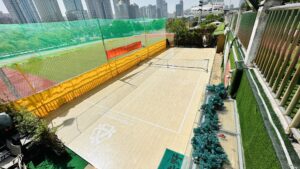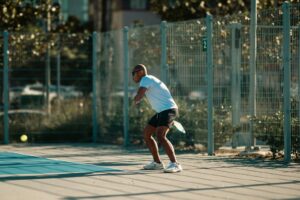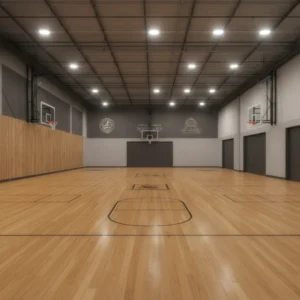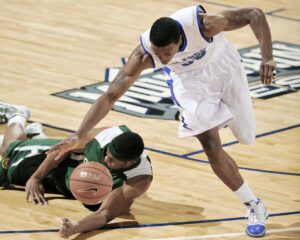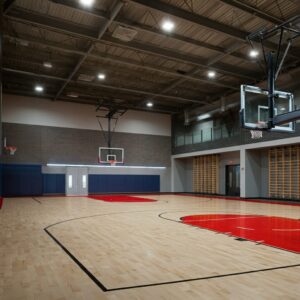Basketball court flooring plays a crucial role in determining player performance, safety, and the overall quality of the game. Whether you’re managing a professional indoor facility or planning a residential outdoor court, selecting the right basketball court flooring can make the difference between an exceptional playing experience and costly maintenance headaches down the road.
The choice between indoor basketball court and outdoor basketball court surfaces involves multiple factors that extend far beyond initial costs. From hardwood’s superior shock absorption to modular tiles’ weather resistance, each basketball flooring option presents unique advantages and challenges. Athletic directors, facility managers, and homeowners must carefully weigh performance characteristics, durability requirements, and long-term maintenance needs when selecting basketball court materials.
Modern basketball court surfaces have evolved significantly, with innovations like coposports biomass sport wooden floor leading the way in sustainable indoor applications, while advanced outdoor hardwood court flooring options challenge traditional assumptions about weather-resistant surfaces. Understanding these differences empowers you to make informed decisions that optimize both player experience and return on investment.
The Role of Flooring in Basketball
Basketball flooring directly impacts every aspect of the game, from ball bounce consistency to player movement patterns. The surface beneath players’ feet affects energy return, joint stress, and injury risk during high-intensity gameplay. Quality basketball court flooring provides consistent traction that allows for quick direction changes while offering enough cushioning to reduce impact stress on players’ knees, ankles, and backs.
Professional basketball hardwood sport flooring must meet strict performance standards for ball rebound, surface friction, and shock absorption. These specifications ensure that players can perform at their peak while minimizing the risk of slip-related injuries or excessive joint stress from hard impacts.
What to Consider When Choosing Basketball Court Flooring
Selecting appropriate basketball court materials requires evaluating several critical factors that influence both immediate performance and long-term satisfaction. Climate conditions, usage frequency, and budget constraints all play significant roles in determining the optimal flooring solution for your specific application.
Indoor basketball flooring benefits from controlled environmental conditions, allowing for materials that might not withstand outdoor exposure. Conversely, outdoor basketball flooring must resist temperature fluctuations, UV radiation, and moisture while maintaining consistent playing characteristics throughout various weather conditions.
Player safety remains the paramount consideration across all basketball flooring options. The ideal surface provides adequate shock absorption to reduce injury risk while offering sufficient grip for confident movement during intense gameplay. These performance characteristics must remain consistent throughout the flooring’s expected lifespan.
Understanding Indoor Court Materials: Hardwood
Hardwood remains the gold standard for indoor basketball court applications, offering unmatched performance characteristics and aesthetic appeal. Traditional maple hardwood provides exceptional durability, consistent ball bounce, and natural shock absorption that enhances player comfort during extended gameplay sessions.
Modern innovations like coposports biomass sport wooden floor represent the latest evolution in sustainable hardwood solutions. These advanced basketball hardwood sport flooring systems combine traditional maple performance with environmentally responsible manufacturing processes, appealing to facilities prioritizing both performance and sustainability.
Hardwood installation requires careful attention to subfloor preparation, moisture control, and climate management systems. Professional installation ensures proper expansion gaps and subfloor cushioning that maximizes the natural shock absorption properties of wood fibers.
Understanding Indoor Court Materials: Synthetic Surfaces
Synthetic indoor basketball flooring offers compelling alternatives to traditional hardwood, particularly for multi-purpose facilities requiring versatile surface solutions. Polyurethane and PVC-based systems provide consistent performance characteristics while offering enhanced durability against heavy usage patterns.
Advanced synthetic basketball court surfaces incorporate specialized cushioning layers that replicate hardwood’s shock absorption properties while providing superior moisture resistance. These systems excel in environments where traditional hardwood might face challenges from humidity fluctuations or multi-sport usage requirements.
Professional-grade synthetic surfaces feature specialized topcoats that ensure consistent traction and ball response characteristics. The controlled manufacturing process allows for precise performance tuning that meets specific facility requirements and usage patterns.
Pros and Cons of Hardwood Flooring
Hardwood basketball flooring delivers unparalleled performance benefits that explain its dominance in professional and collegiate facilities. The natural shock absorption reduces player fatigue and injury risk, while consistent grain patterns provide reliable traction for confident movement patterns.
However, hardwood requires significant maintenance commitments and controlled environmental conditions to maintain peak performance. Regular refinishing schedules, humidity control systems, and protective measures during non-basketball events represent ongoing operational costs that facilities must budget for throughout the floor’s lifespan.
Cost considerations extend beyond initial installation, as quality hardwood systems require professional maintenance and periodic refinishing to preserve performance characteristics. Despite higher upfront investments, hardwood’s longevity and performance consistency often justify the premium for serious basketball applications.
Pros and Cons of Synthetic Flooring
Synthetic basketball court materials excel in versatility and maintenance simplicity, making them attractive options for multi-purpose facilities and budget-conscious applications. These surfaces resist moisture damage and require minimal ongoing maintenance compared to traditional hardwood systems.
Modern synthetic systems closely replicate hardwood performance characteristics while offering enhanced durability against heavy usage patterns. The controlled manufacturing process ensures consistent quality and performance specifications that remain stable throughout the product’s lifespan.
Limitations include potential aesthetic differences compared to natural hardwood and varying performance characteristics depending on specific product formulations. Some synthetic surfaces may not provide the exact feel and response that serious players expect from traditional hardwood courts.
Understanding Outdoor Court Materials: Asphalt and Concrete
Traditional outdoor basketball flooring relies heavily on asphalt and concrete surfaces due to their weather resistance and durability characteristics. These materials provide solid foundations that withstand temperature extremes and moisture exposure while offering consistent playing surfaces for recreational basketball activities.
Asphalt surfaces offer slightly better shock absorption than concrete, though both materials provide significantly less cushioning than indoor alternatives. Proper installation with adequate base preparation and drainage systems ensures long-term performance and minimizes maintenance requirements.
Surface treatments and coatings enhance the basic performance of asphalt and concrete courts, providing improved traction and ball bounce characteristics. Regular maintenance of these coatings preserves playing quality and extends the functional lifespan of the underlying surface.
Understanding Outdoor Court Materials: Modular Polypropylene Tiles
Modular tile systems represent significant advances in outdoor basketball flooring technology, offering performance characteristics that approach indoor quality while maintaining weather resistance. These interlocking systems provide superior shock absorption compared to traditional concrete or asphalt surfaces.
Installation flexibility makes modular tiles attractive for residential and community applications where traditional court construction might not be feasible. The modular design allows for easy replacement of damaged sections without affecting the entire court surface.
Advanced modular systems incorporate drainage features and specialized surface textures that enhance performance in various weather conditions. Some premium tiles even accommodate outdoor hardwood court flooring appearance while maintaining plastic’s durability advantages.

Pros and Cons of Asphalt and Concrete
Asphalt and concrete excel in durability and cost-effectiveness for outdoor basketball applications. These materials withstand severe weather conditions and heavy usage patterns while requiring minimal ongoing maintenance when properly installed and finished.
The primary advantages include low initial costs, excellent weather resistance, and minimal maintenance requirements once proper surface treatments are applied. These surfaces can provide decades of reliable service with appropriate installation and periodic resurfacing.
Disadvantages center around limited shock absorption and potential for harsh impacts during gameplay. Players may experience increased joint stress and fatigue during extended sessions on these harder surfaces compared to cushioned indoor alternatives.
Pros and Cons of Modular Polypropylene Tiles
Modular polypropylene tiles offer the best balance of performance and practicality for many outdoor basketball applications. Superior shock absorption compared to concrete reduces player fatigue while weather-resistant materials ensure consistent performance throughout various climate conditions.
Installation advantages include DIY-friendly systems that don’t require specialized contractors or heavy equipment. Damaged sections can be easily replaced without affecting surrounding areas, minimizing long-term maintenance costs and downtime.
Cost considerations vary significantly depending on tile quality and system complexity. Premium modular systems may approach the cost of traditional construction while providing enhanced performance and maintenance benefits that justify the investment.
Weather Resistance and UV Stability: Key Considerations for Outdoor Courts
Outdoor basketball flooring must withstand continuous UV exposure, temperature cycling, and moisture variations that would quickly damage indoor-specific materials. UV stabilization prevents color fading and material degradation that could compromise surface texture and performance characteristics.
Temperature stability ensures consistent playing characteristics throughout seasonal variations. Materials must resist expansion and contraction that could create uneven surfaces or joint separation that affects ball bounce and player safety.
Moisture management through proper drainage and surface design prevents water accumulation that could create slip hazards or freeze-thaw damage in colder climates. Effective drainage systems extend surface life while maintaining safe playing conditions.
Shock Absorption and Safety: Protecting Players on the Court
Shock absorption capabilities directly impact player safety and comfort across all basketball court surfaces. Adequate cushioning reduces impact forces transmitted to players’ joints during jumping and running activities that define basketball gameplay.
Indoor surfaces typically provide superior shock absorption through specialized subfloor systems and material properties. However, advanced outdoor options like premium modular tiles now offer cushioning characteristics that approach indoor performance levels.
Safety considerations extend beyond shock absorption to include surface traction, consistency, and stability. Players must trust their footing during rapid direction changes and aggressive defensive movements that require reliable surface grip.
Maintenance and Longevity: Maximizing Your Investment
Proper maintenance schedules preserve performance characteristics and extend the functional lifespan of basketball court materials. Indoor hardwood requires regular cleaning, controlled humidity, and periodic refinishing to maintain peak performance standards.
Outdoor surfaces benefit from regular cleaning and periodic surface treatments that restore traction and appearance. Modular systems may require occasional tile replacement, while traditional surfaces need periodic resurfacing to maintain optimal playing characteristics.
Preventive maintenance proves more cost-effective than reactive repairs, particularly for premium flooring systems. Established maintenance schedules preserve warranty coverage while ensuring consistent performance throughout the surface’s expected lifespan.
Cost Analysis: Comparing Flooring Options
Initial installation costs vary significantly between indoor and outdoor basketball flooring options. Premium hardwood systems represent the highest upfront investment but offer unmatched performance and longevity when properly maintained.
Synthetic indoor surfaces provide middle-ground solutions with moderate installation costs and reduced maintenance requirements. These systems appeal to facilities requiring good performance characteristics without hardwood’s maintenance commitments.
Outdoor options range from economical concrete solutions to premium modular systems that approach indoor performance levels. Long-term cost analysis must include maintenance requirements, expected lifespan, and replacement costs to accurately compare total ownership expenses.
Installation and Construction: What to Expect
Professional installation ensures optimal performance and longevity regardless of chosen basketball court materials. Indoor installations require precise subfloor preparation, moisture barriers, and specialized fastening systems that maximize surface performance characteristics.
Outdoor installations focus on proper base preparation, drainage systems, and surface treatments that withstand environmental exposure. Quality installation prevents common problems like settling, cracking, or drainage issues that could compromise long-term performance.
Timeline considerations vary significantly between installation types, with outdoor concrete courts requiring extended curing periods while modular systems may be playable immediately after installation completion.
Case Studies: Successful Basketball Court Installations
Educational facilities consistently report high satisfaction with professional hardwood installations that provide decades of reliable service. Proper maintenance programs preserve performance characteristics while managing long-term operational costs effectively.
Community recreational facilities often prefer synthetic or modular outdoor solutions that balance performance with maintenance simplicity. These installations demonstrate how appropriate material selection meets specific usage patterns and budget constraints.
Residential installations showcase the versatility of modern modular systems that provide quality playing experiences without requiring extensive site preparation or ongoing professional maintenance commitments.
Future Trends in Basketball Court Flooring
Sustainable materials like coposports biomass sport wooden floor represent growing trends toward environmentally responsible flooring solutions that maintain traditional performance standards. These innovations appeal to facilities prioritizing sustainability without compromising playing quality.
Advanced synthetic materials continue improving performance characteristics while offering enhanced durability and reduced maintenance requirements. Next-generation surfaces may eventually match hardwood performance while providing superior practical advantages.
Smart surface technologies incorporating sensors and performance monitoring capabilities may revolutionize how facilities manage court maintenance and performance optimization. These systems could provide real-time data on surface conditions and usage patterns.

FAQs: Addressing Common Questions About Basketball Court Flooring
What’s the best basketball court flooring for outdoor use?
Modular polypropylene tiles offer the best balance of performance, durability, and maintenance simplicity for most outdoor applications. These systems provide superior shock absorption compared to concrete while withstanding weather exposure effectively.
How long does hardwood basketball flooring last?
Quality hardwood basketball floors can provide 30-50 years of service with proper maintenance and periodic refinishing. Regular care programs preserve performance characteristics while maximizing return on investment.
Can outdoor basketball courts use hardwood flooring?
Traditional hardwood isn’t suitable for outdoor exposure due to moisture sensitivity. However, specialized outdoor hardwood court flooring systems with enhanced weather resistance are available for covered or semi-outdoor applications.
What’s the most cost-effective basketball flooring option?
Concrete surfaces offer the lowest initial costs for outdoor applications, while synthetic surfaces provide good value for indoor use. However, total cost analysis should include maintenance and replacement expenses over the expected lifespan.
How much does professional basketball court installation cost?
Installation costs vary significantly based on surface type, site conditions, and local labor rates. Indoor hardwood systems typically range from $8-15 per square foot, while outdoor options may cost $3-12 per square foot depending on chosen materials.
Making the Right Choice for Your Basketball Court
Selecting appropriate basketball court flooring requires careful evaluation of performance requirements, environmental conditions, and long-term operational considerations. Indoor applications benefit from hardwood’s superior performance characteristics, while outdoor courts need weather-resistant materials that maintain consistent playing quality.
Budget analysis must consider both initial installation costs and ongoing maintenance requirements to accurately compare total ownership expenses. Premium materials often provide better long-term value through extended lifespan and reduced maintenance needs.
Professional consultation ensures optimal material selection and installation quality that maximizes performance and durability. Contact us today for a free consultation and quote for your basketball court flooring needs, where our experts can help you navigate the complex decisions involved in creating the perfect playing surface for your specific requirements.


